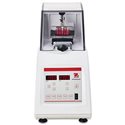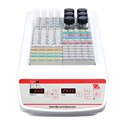
The World Health Organization (WHO) estimates that 60–80 million couples worldwide currently suffer from infertility.1 It varies across regions of the world and is estimated to affect 8–12 percent of couples worldwide.2 This has led to more than just personal strife and big business for fertility clinics; it has led to a wave of biological research on the causes, diagnoses, and treatment of infertility.
And the focus of the medical, scientific, and academic communities has been shifting as the latest research shows that between 45 and 50 percent of infertility cases are thought to stem from factors that affect men. And the problem is worsening. While female infertility rates have actually decreased in recent years, those of males have risen, and not among older men as might be assumed. The fertility rate in men younger than age 30 has decreased worldwide by 15% in the past 25 years.3
Learn more about the products featured in this article: OHAUS Bead Mill Homogenizers, OHAUS Centrifuges, OHAUS Vortex Mixers, OHAUS Dry Block Heaters.
An Alarming Epidemic
Scientists and researchers recognize the urgency as the ramifications of declining male fertility are far reaching.
 According to Dr. Elizabeth Snyder, Assistant Professor, Department of Animal Sciences, Rutgers University, studies indicate that sperm quality has been decreasing over the last decade, which could lead to populations existing on a “sub-replacement” level. “That’s when each new generation is less populous than the older one,” explains Dr. Snyder. “It refers to any rate below approximately 2.1 children born per woman.”
According to Dr. Elizabeth Snyder, Assistant Professor, Department of Animal Sciences, Rutgers University, studies indicate that sperm quality has been decreasing over the last decade, which could lead to populations existing on a “sub-replacement” level. “That’s when each new generation is less populous than the older one,” explains Dr. Snyder. “It refers to any rate below approximately 2.1 children born per woman.”
Beyond the impact on family planning, male infertility may also serve as a biomarker for other health related problems. A male with poor sperm quality could be at an increased risk for other, more serious health issues.
Possible Causes and Moving Targets
One of the major issues challenging scientists and researchers, is that possible causes and even direct effects of infertility vary widely from case to case.
Accor ding to Prof. Richard Sharpe of the MRC Center for Reproduction Health at the University of Edinburgh, there are two factors that make accurate predictions and diagnoses difficult. One is the relatively poor quality of human semen. According to his research, the average human male actually produces a lot of infertile or useless sperm per ejaculation. To put it into perspective, consider this: despite the large differences in scrotal size and amount of ejaculate, human males actually produce the same amount of virile sperm per ejaculation as the average hamster.
ding to Prof. Richard Sharpe of the MRC Center for Reproduction Health at the University of Edinburgh, there are two factors that make accurate predictions and diagnoses difficult. One is the relatively poor quality of human semen. According to his research, the average human male actually produces a lot of infertile or useless sperm per ejaculation. To put it into perspective, consider this: despite the large differences in scrotal size and amount of ejaculate, human males actually produce the same amount of virile sperm per ejaculation as the average hamster.
The other factor plaguing research in this area is simply the amount of variations that exist from person to person. In his 2019 study “Lifestyle and Environmental Contribution to Male Infertility,” Prof. Sharpe writes: “The poor average quality of human semen, combined with the naturally great variation in semen quality between individuals and from ejaculate to ejaculate in the same individual means that cross-sectional studies in men face an uphill task when attempting to establish whether or not occupation, lifestyle, or other environmental exposures are able to affect sperm production or quality.”
Sharpe continues on, however, pointing to several possible occupational and lifestyle conditions such as exposure to excessive heat, exposure to pesticides, or the use of recreational drugs. As if it weren’t difficult enough to pin down causes and effects, Sharpe points out that although there is evidence to suggest that there is a 30% reduction in sperm production in the summer versus the winter, researchers are unable to say definitively if it’s just the rise in temperature or other factors such as looser clothing, air-conditioning, and other environmental factors. It always seems to be a moving target.
Whether the causes are genetic, hereditary, environmental, dietary or attributable to lifestyle habits, scientists like Dr. Snyder are still determined to get to the bottom of it. “Our laboratory aims to improve male reproductive health by increasing our understanding of male germ cell RNA biology. These findings may also have direct impacts on how we diagnose and treat infertility as well as develop safe, reversible male contraceptives.”
A Male Pill is in the Works
The last part Dr. Snyder alluded to has become an ancillary focus of all this research. The development of a non-hormonal male contraceptive (i.e., a male version of “the pill”) has the potential to give men the ability to regulate or control their fertility cycle. There are currently no commercially available oral contraceptives for men, but that could soon change.
There are now s cientific efforts funded by the National Institute of Health (NIH) and the Male Contraceptive Initiative (MCI) to identify non-hormonal, reversible contraceptives. Extensive laboratory work is focused on sperm development in the testis, sperm function in the female reproductive tract, as well as multiple projects focused on impacted ejaculated sperm.
cientific efforts funded by the National Institute of Health (NIH) and the Male Contraceptive Initiative (MCI) to identify non-hormonal, reversible contraceptives. Extensive laboratory work is focused on sperm development in the testis, sperm function in the female reproductive tract, as well as multiple projects focused on impacted ejaculated sperm.
It may be a while yet until the first male contraceptive reaches the market, however with new funding in place, plus the hard work of dedicated scientists and researchers, clinical trials may not be that far off. A variety of methods are being explored, including disrupting new sperm production, decreasing sperm motility, and preventing sperm-egg interaction.4 Research findings have come a long way and though these methods are extremely early in development, they show immense promise.
Outfitting An Effective and Efficient Male Fertility Lab
With so many factors at play in the study of the root causes and possible treatments for male infertility, it’s even more vital that lab equipment delivers precise, accurate, and repeatable results.
OHAUS offers a comprehensive selection of safe, intuitive, and compact options for every lab.

Bead Mill Homogenizer
Extracting small amounts of RNA from hard-to-process samples requires a high-quality and flexible homogenizer. The OHAUS Bead Mill Homogenizer can be used with or without attachments, and its linear motion is statistically proven to break samples up more effectively than a horizontal motion.
 Centrifuges
Centrifuges
OHAUS offers durable, high-quality centrifuges that come with a variety of rotors, allowing researchers the ability to create reproducible results without worrying about machine wear and tear.
 Mixers
Mixers
When it comes to mixers, OHAUS offers a range of products to suit the needs of any lab, including mini, microplate, heavy duty and multi-vortex mixers.
 Block Heaters
Block Heaters
When choosing a dry block heater, be sure to look for high quality temperature control and make sure the unit features a heated lid like the OHAUS 2 Block to minimize condensation which can compromise sample integrity.
Wherever future discovery takes scientists, OHAUS will be there to support them with durable precision instruments and unwavering support.
Learn more about the products featured in this article: OHAUS Bead Mill Homogenizers, OHAUS Centrifuges, OHAUS Vortex Mixers, OHAUS Dry Block Heaters.

1Calverton, Maryland, USA: ORC Macro and the World Health Organization; 2004. World Health Organization. Infecundity, Infertility, and Childlessness in Developing Countries. DHS Comparative Reports No 9.
2Infertility: an international health problem., Sciarra J, Int J Gynaecol Obstet. 1994 Aug; 46(2):155-63.
3Infertility and impaired fecundity in the United States, 1982-2010: data from the National Survey of Family Growth., Chandra A, Copen CE, Stephen EH, Natl Health Stat Report. 2013 August 14; (67):1-18, 1 p following 19.
4Future prospects. 2018 Male Contraceptive Initiative (MCI) March www.malecontraceptive.org/male-contraception-research/prospective-male-contraceptive-options/